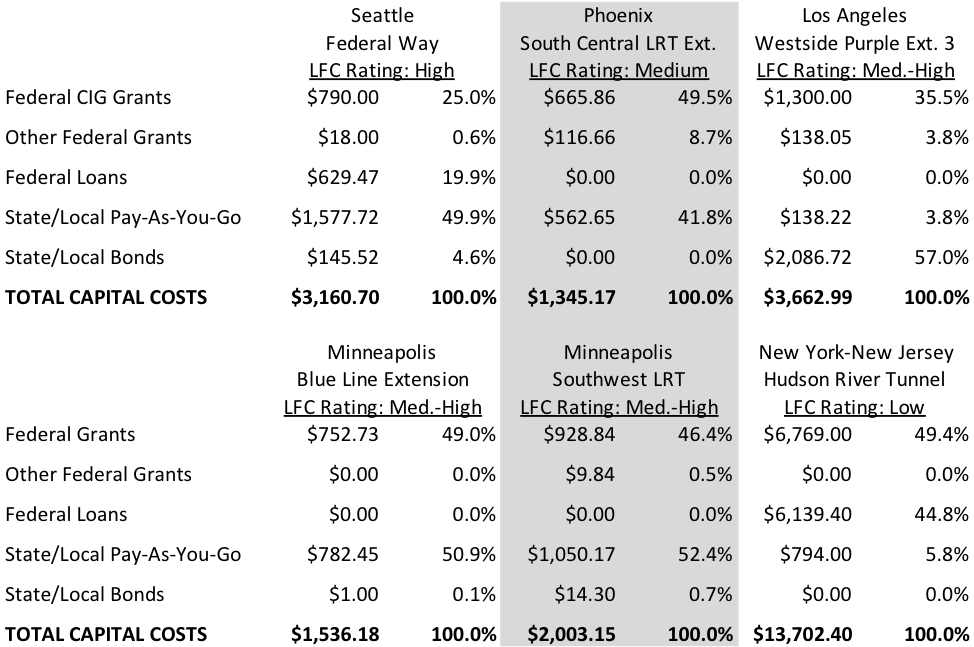Shortly before Congress adjourned last month, the Federal Transit Administration sent Congress formal notification that FTA intends to sign a full funding grant agreement (FFGA) with Sound Transit promising to provide $790 million in past and future federal appropriations towards the construction of a 7.8-mile light rail extension of the Red Line from Angle Lake (just south of Sea-Tac Airport) moving southwards to Federal Way. Total project cost will be $3.2 billion.
Federal law requires FTA to notify Congress no less than 30 days before executing a FFGA with a transit agency, and the 30-day notice was sent up to the Hill on December 13, so the agreement should be signed on or shortly after January 12. This is a bit of a fait accompli – as part of the funding plan for the Federal Way project, the U.S. Department of Transportation already closed on a $629.5 million TIFIA loan to Sound Transit, to be repaid from dedicated Seattle-area sales tax revenues.
Sound Transit is the only state or local government to date that has entered into a “master credit agreement” for TIFIA with USDOT. The agreement executed in December 2016 called for four individual TIFIA loans (for the Federal Way, Lynnwood Link, Northgate Link, and O&M Facility East projects) totaling $2.0 billion. At the time, Sound Transit predicted that negotiating one big TIFIA credit agreement would save the agency $200-300 million in long-term borrowing costs.
The TIFIA loan for Federal Way closed last month. The whole process was delayed a bit due to uncertainty over how the November 2019 ballot measure (Initiative 976) repealing local car tax increases for Sound Transit would affect the project. Sound Transit says they have provided FTA with the results of “stress tests” showing that no matter how the courts interpret Initiative 976, the funding stream for Federal Way will not be affected.
Of the $790 million in appropriations for Federal Way that are promised by the grant agreement, $100 million was appropriated by Congress in fiscal 2019 and was already allocated by FTA towards the project. The just-enacted FY 2020 appropriations act provided $1.46 billion for ongoing and future “new start” Capital Investment Grant (CIG) projects, of which another $100 million is expected to be allocated towards Federal Way, and on and on for five years after that.
After the Federal Way extension is completed, the eventual plan is for Sound Transit to extend the Red Line southwards to connect with Tacoma and provide a direct light rail connection between Tacoma and Seattle. (Ed. Note: After this article was published, we were informed that they aren’t going to call it the Red Line anymore.)
Federal Way will represent the fifth major multi-year FFGA signed by the Trump Administration from the FTA CIG program to date, following the Caltrain Peninsula Corridor electrification project (May 2017), Maryland Purple Line (August 2017), Santa Ana streetcar (November 2018) and Seattle Lynnwood Link (December 2018) projects. (These are in addition to 20 one-off “small start” CIG projects.)
The last CIG update from FTA (October 2019) indicated that four more multi-year FFGAs were “anticipated for execution” in the coming months – Federal Way, plus the third and final segment of the Los Angeles Purple Line Westside extension, the Phoenix Valley Metro South Central light rail extension, and the San Francisco Transbay Corridor core capacity increase project.
The Federal Way project managed to receive a “high” rating from the career FTA staff for its local financial commitment – the highest on the five-point rating scale. Comparing Federal Way with four of the other projects in the Engineering phase of the new start program (L.A. Westside, Phoenix South Central, and the two Minneapolis projects) can shed some light on what kinds of financial plans get high versus medium-high and medium local financial commitment ratings. (The Phoenix plan is in flux – after the last rating shown below (Nov. 2018), they wrote to FTA to ask to amend their plan to lower the CIG share from 49.5 percent of project cost to 39.4 percent, but we don’t have the rest of that plan.)
The table also adds the Hudson River Tunnel (not yet in the Engineering phase, but still mired in the Project Development phase) in its 2018 financial plan, which managed to get a “Low” rating from the FTA career staff on its local financial commitment, for comparison.

(The Hudson Tunnel sponsors amended their financial plan in August 2019, dropping the size of the CIG grant request to $5.339 billion and dropping the overall project cost to $12.127 billion. We will see next month if this was enough to get the rating increased from “low.”)
(This article was amended after original publication to clarify the timing of the closing of the TIFIA loan.)




